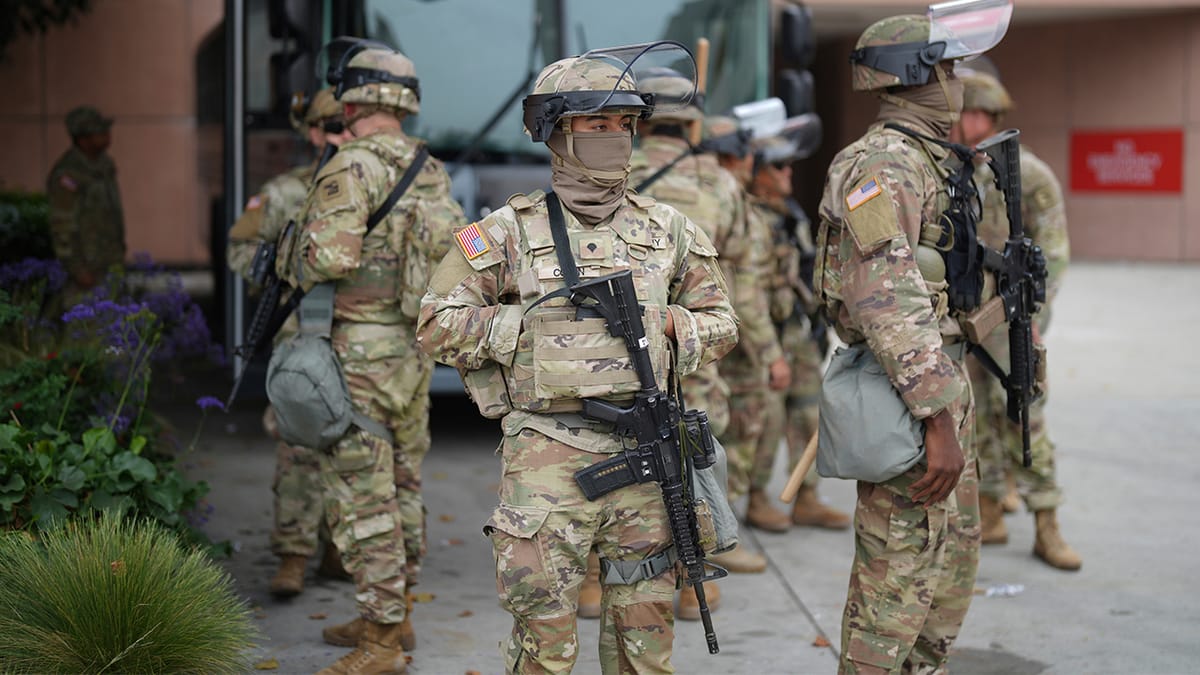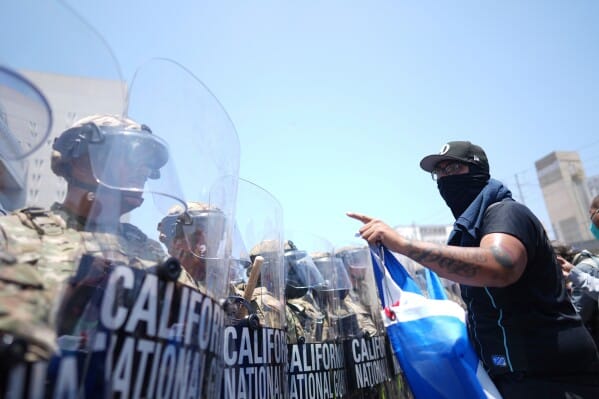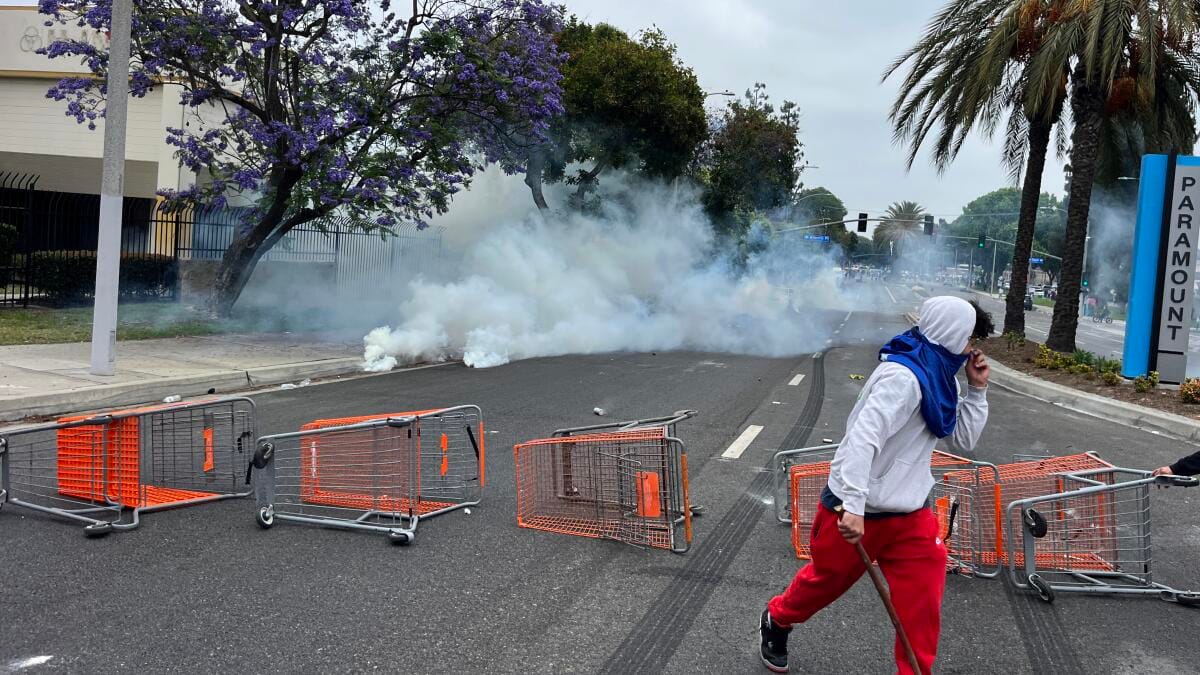ICE Raids & National Guard: Is LA in a Constitutional Crisis?
ICE raids in Los Angeles have triggered mass protests. This blog investigates the legal, civic, and political fallout of LA’s unprecedented National Guard presence under Title 10.

LOS ANGELES, June 25, 2025
In early June, aggressive ICE workplace raids swept through Los Angeles. In response, the federal government deployed thousands of National Guard troops and active-duty Marines without Governor Gavin Newsom's approval. This immigration crackdown has turned into a significant constitutional conflict, challenging the balance between federal authority and state control and testing the limits of military deployment within the U.S.
Seeing soldiers in camouflage patrolling the streets of Los Angeles raised concerns across the country.
Is this a justified act of federal law enforcement, or is it setting a risky precedent?
With historic court cases emerging, large protests starting, and legal experts criticizing the move, Los Angeles may be at a crucial turning point for constitutional law.
Legal Framework: Title 10, Posse Comitatus & Insurrection Act
Title 10 U.S.C. § 12406 gives the president the power to call National Guard units into federal service during an invasion, rebellion, or when federal laws cannot be enforced with normal forces. However, critics argue about the interpretation of this statute. They believe that while § 12406 allows for federalization, it does not override the Posse Comitatus Act of 1878, which broadly prohibits military forces from fulfilling domestic law enforcement roles.
Additionally, federalization generally requires coordination with state governors. Experts like Joseph Nunn suggest the wording is unclear, but Newsom's legal team argues that ignoring him violates statutory text and constitutional tradition.
The Insurrection Act (10 U.S.C. §§ 331–335) allows broader military action when laws cannot be enforced through normal means. The Trump administration did not use it here, relying only on § 12406 and claiming inherent authority.
A Brennan Center analysis warns that using § 12406 alone to justify armed deployments risks bypassing essential legislative safeguards meant to limit domestic military use.

Judicial Battlefront: Courts Weigh In
On June 11, U.S. District Judge Charles Breyer decided that the deployment violated both the Tenth Amendment and Posse Comitatus. He ordered the federal troops to return to state control.
A short time later, the Ninth Circuit Court of Appeals issued a temporary stay, allowing the deployment to continue. The three-judge panel, which included two Trump appointees and one Biden appointee, found “credible evidence” of violence toward federal officers and ruled that the federal action fell within the Title 10 scope.
The legal tug-of-war goes on, with Judge Breyer this week requesting a briefing on whether the Posse Comitatus Act was broken.
A potential Supreme Court showdown is on the horizon. With fundamental questions at stake regarding state versus federal power, the use of force, and civil liberties, the ruling could reshape American governance.
Legal Expert Analysis & Official Statements
Jeremy R. Paul from Northeastern University Law states:
“Most of the time, the president typically waits and gets a request from the governor.”
ACLU National Security Director Hina Shamsi states:
“President Trump’s deployment is unnecessary, inflammatory, and an abuse of power…it puts Angelenos in danger and undermines our fundamental democratic principle.”
Joseph Nunn of the Brennan Center describes § 12406 as “troublingly ambiguous” and argues that deploying troops without the Insurrection Act is a “statutory and constitutional stretch.”
Governor Gavin Newsom strongly criticized the action as a “serious breach of state sovereignty.” He referenced historical examples—from Little Rock, AR (1962) to Selma—where federal troops intervened after court orders. He asserted that no match to this unilateral move.
Attorney General Rob Bonta and 18 other state attorneys general filed briefs claiming abuse of presidential power and posing risks to constitutional balance.
Federal Response: White House & Advocates
The White House defended the action under Title 10 and the inherent power to protect federal officials and property. DOJ Attorney Christopher Edelman backed the deployment, citing violence and legal precedent.
Former President Trump called the Appeals Court ruling a “BIG WIN,” emphasizing that federal authority cannot be blocked by state governments.
Vice President J.D. Vance, during his LA visit, asserted that the action was “legitimate” and promised similar steps if threats continued.

Public Reaction: Protests, Coverage & Community Impact
On the Streets
Protest videos from Los Angeles—Downtown, Compton, Paramount, Westlake—show tense moments: National Guard alongside federal police, clouds of tear gas, rubber bullets, and protesters shouting, “Protect, don’t militarize!”
The ACLU filed a lawsuit on June 7, challenging excessive force by ICE and DHS agents during the raids. The lawsuit documents seized cameras, targeted journalists, and disrupted peaceful assembly.
Civil rights groups like the LDF, ACLU, and Amnesty International caution against limiting free speech. An LDF press release stated that protesters “have a constitutional right to express concern with this administration’s inhumane immigration policies.”
Faith leaders, including Pastor Kevin Kang, have organized fasting and prayer vigils under the banner “Summer of Resistance” to support immigrant communities.
A Reuters/Ipsos poll conducted from June 11–12 shows that national sentiment is deeply divided. While 48% support troop deployment, Californians oppose it by 58% to 32%.
Broader Political & Historical Context
Many compare this situation to events in 1962 in Mississippi and Little Rock in 1957. However, a key difference is that those deployments were court-ordered or coordinated with state officials. In this case, state leadership is against it.
In 2020, federal deployments in Portland led to similar reactions. Oregon Governor Kate Brown criticized them as “a blatant abuse of power,” calling for the federal withdrawal.
This ongoing conflict highlights the differences between Title 10 and Title 32. Title 10 federalizes the Guard, while Title 32 keeps them under state control. This also emphasizes the legislative confusion around “protective” roles versus direct enforcement.
What Happens Next?
High-stakes judicial escalation:
- Ninth Circuit hearings in the coming week will decide if Judge Breyer's injunction can be permanently overturned.
- The Supreme Court might become the final decider of federal versus state supremacy regarding domestic troop use.
Clarifying military roles:
- The courts may rule on whether Title 10 allows the federal government to enforce laws directly or if military interventions require Insurrection Act support.
- They will also explore whether federal deployments violate the Posse Comitatus Act when based solely on § 12406.
Safety and strategy adjustments:
- The Pentagon may create new rules of engagement and guidelines to restrict active-duty roles, especially for Marines.
- This could lead lawmakers to revise Title 10, establishing clearer guidelines for Guard activation.
Political implications:
- Governors may feel empowered to legally challenge federal overreach. States might push for reform.
- For Trump and his allies, this move reinforces the narrative of using power “to protect” immigrants and solidifying federal control.
- Civil rights advocates will continue legal and civic partnerships, influencing local elections and public discourse.
Community consequences:
- Lawyers warn of “chilling effects” on protesters, civil rights observers, and journalists.
- Immigrant communities feel heightened fear, prompting legal aid organizations to launch “Know Your Rights” campaigns.

“President Trump’s deployment is unnecessary, inflammatory, and an abuse of power.”
— Hina Shamsi, ACLU National Security Project Director
The Constitutional Crossroads
Los Angeles has become the center of a constitutional crisis that reflects long-standing tensions over federalism and civil-military boundaries. The question is no longer just theoretical; it is active in our streets, courtrooms, and civic discussions. As the judiciary deliberates, Americans must confront a critical issue: can—or should—the president use military force in our cities against a state’s expressed wishes?
What’s Your Take?
In ensuring federal law enforcement and property, should the president have the power to deploy military forces even against state objections? How can we balance federal security needs with the preservation of state sovereignty and civil liberties?
Sources
- Court rulings and legal policy: Justia (Title 10, Posse Comitatus, Insurrection Act), Cornell Law database, U.S. District Court and Ninth Circuit decisions (June 11–20), Brennan Center analysis.
- News reporting and legal analysis: Associated Press, Reuters, San Francisco Chronicle, CBS News, NPR, Lawfare, The Guardian, LA Times, PBS, Time, ABC News.
- Official government and university statements: Office of Governor Gavin Newsom, California Attorney General press release, U.S. Department of Justice brief (June 13), ACLU and Amnesty International statements.
- Public sentiment and civic response: Reuters/Ipsos poll (June 11–12), protest footage and imagery (via AP, Getty, ABC7), quotes from legal experts including Jeremy R. Paul, Hina Shamsi, and Joseph Nunn.
- Trend and civic data tools: Google Trends (June 1–20), Wayback Machine (federal deployment pages), BoomLive protest verification reports.




